#scutigeromorpha
Explore tagged Tumblr posts
Text
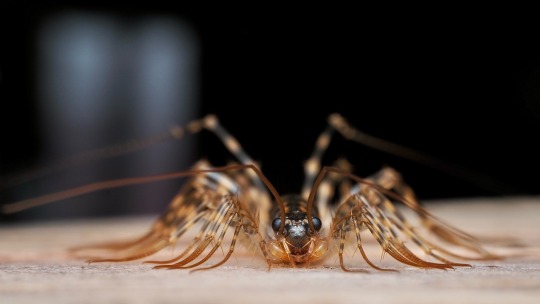
eye level with a crevice angel, Thereuonema tuberculata.

a sweet pet of mine, graciously sitting still for the camera. I think he has a nice smile
3K notes
·
View notes
Text
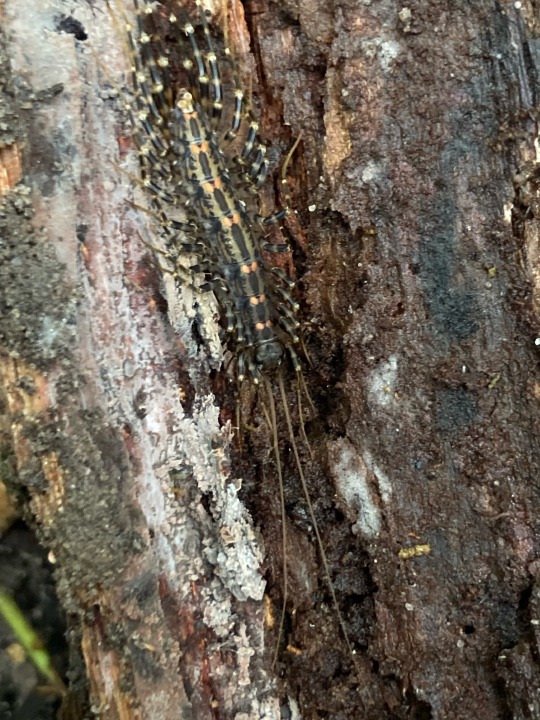


the most wonderfully calm and polite allothereua maculata i have ever met. usually they're incredibly scrambly and run around in an understandable panic but this guy was chilling in a crevice in some fallen bark. wonderful.
#centipede#house centipede#myriapoda#chilopoda#scutigeromorpha#allothereua#allothereua maculata#i almost didnt recognise this guy as a house centipede because i flipped the bark and it didn't immediately start running in circles#also do any centipede enjoyers know if allothereua maculata is myrmecophilous at all? i see them a lot under rocks with ant nests
284 notes
·
View notes
Photo
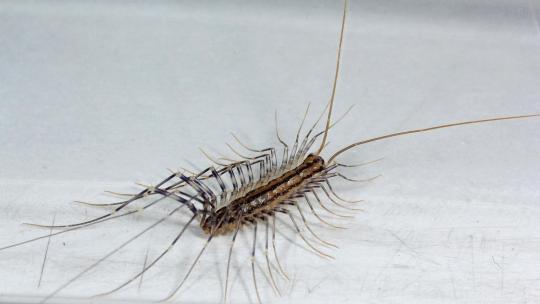
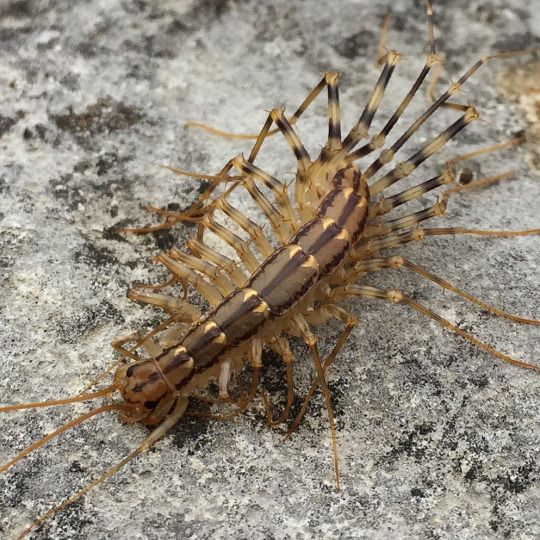
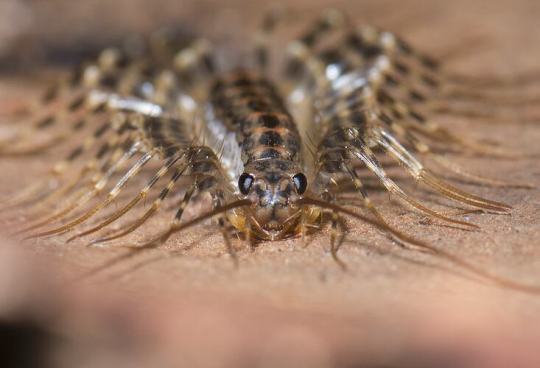
Open Your Home to the Common House Centipede
A common sight in homes throughout Europe, Asia, the Americas, and Australia the common house centipede (Scutigera coleoptrata) is a medium-sized species of centipede originally from the Mediterranean. In the wild, they prefer grasslands and deciduous forests where they can hide under rocks, logs, or leaf litter. These insects have also adapted well to urban development, and are frequently found in basements, bathrooms, and garages, as well as gardens and compost piles.
Like other centipedes, the common house centipede has less than 100 legs; in fact, they only have 15 pairs, with the front pair used only for holding prey or fending off threats. All those legs let the common house centipede move up to 0.4 meters per second (1.3 ft/s) over a variety of surfaces, including walls and ceilings. The actual body of S. coleoptrata is only 25 to 35 mm (1.0 to 1.4 in) long, but the antennae are often as long as the body which can give this insect a much larger appearance. However, they can be hard to spot, especially in their natural environments; their tan and dark brown coloration allows them to blend in seamlessly to surrounding vegetation.
Though they pose little threat to humans, house centipedes are predatory. Their primary food source is other arthropods, including cockroaches, silverfish, bed bugs, ticks, ants, and insect larvae. S. coleoptrata is a nocturnal hunter, and uses its long antennae to track scents and tactile information. Their compound eyes, unusual for centipede species, can distinguish daylight and ultraviolet light but is generally used as a secondary sensory organ. When they do find prey, house centipedes inject a venom which can be lethal in smaller organisms, but is largely harmless to larger animals. This makes them important pest controllers. In the wild, house centipedes are the common prey of rodents, amphibians, birds, and other insects.
The mating season for S. coleoptrata begins in the spring, when males and females release pheromones that they can use to find each other. Once located, the male spins a silk pad in which he places his sperm for the female to collect. She then lays fertilized eggs in warm, moist soil in clutches of 60-150. These eggs incubate for about a month, and the young emerge with only four pairs of legs. Over the next three years, juvenile house centipedes molt 7 times, each time gaining new pairs of legs. After they grow their last pair of legs, immature house centipedes molt an additional 3 times, at which time they become sexually mature. If they can avoid predation, individuals can live up to 7 years in the wild.
Conservation status: The common house centipede has not been evaluated by the IUCN, as it is relatively common both in the wild and in urban areas. Although they have been introduced to areas outside their native range, no detrimental environmental effects have been associated with their spread.
If you like what I do, consider leaving a tip or buying me a ko-fi!
Photos
Joseph Berger
David Paul
Conrad Altman via iNaturalist
#common house centipede#Scutigeromorpha#Scutigeridae#centipedes#myriapoda#myriapods#insects#arthropods#deciduous forests#deciduous forest arthropods#grasslands#grassland arthropods#urban fauna#urban arthropods#europe#north america#south america#asia#australia#oceania#animal facts#zoology#biology
627 notes
·
View notes
Text


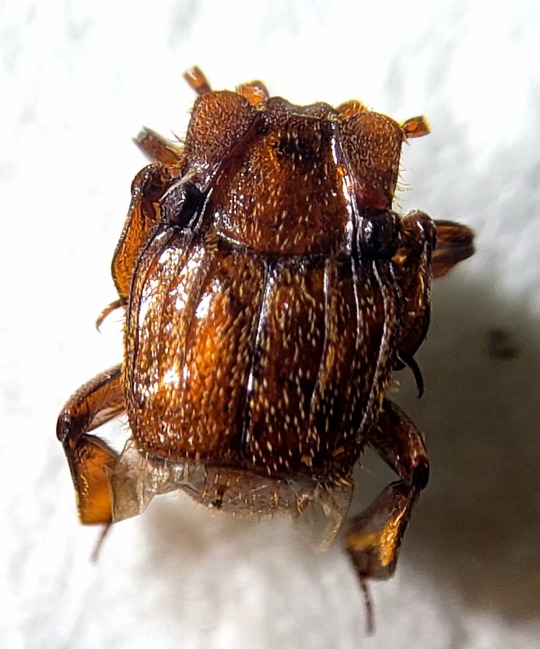


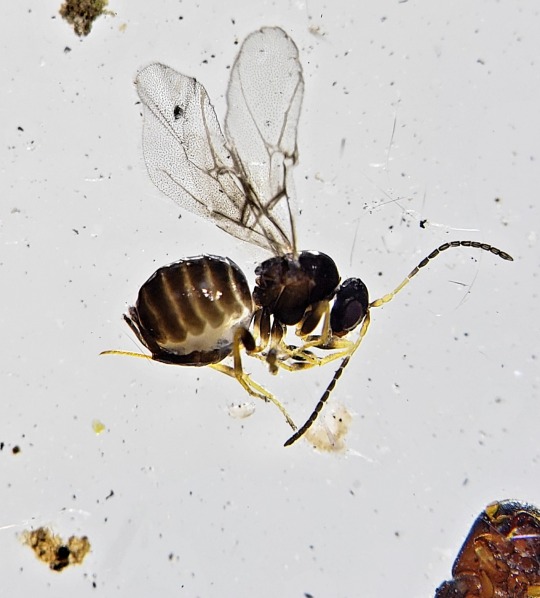
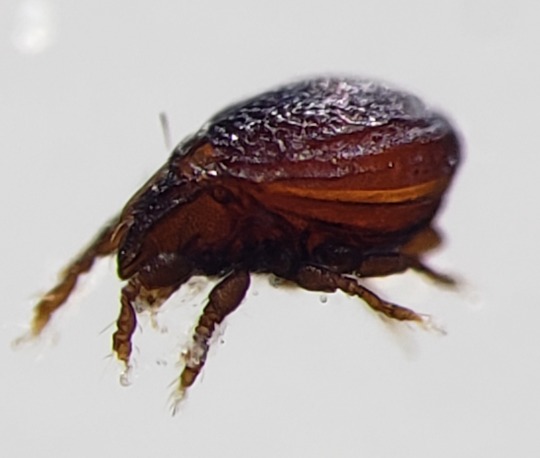

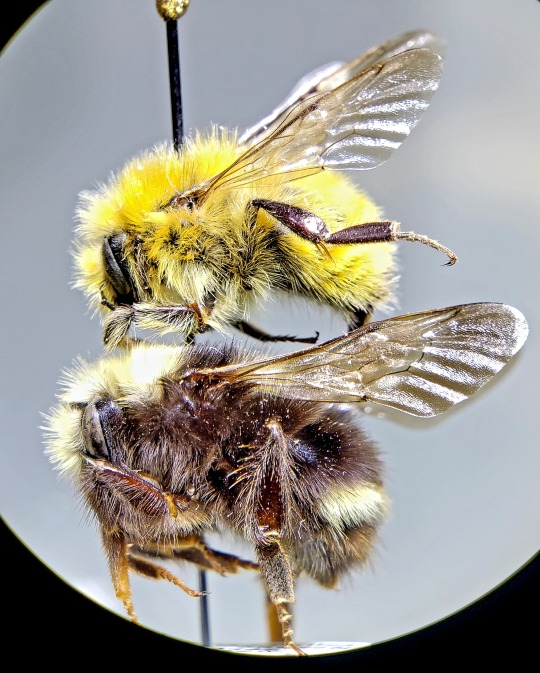

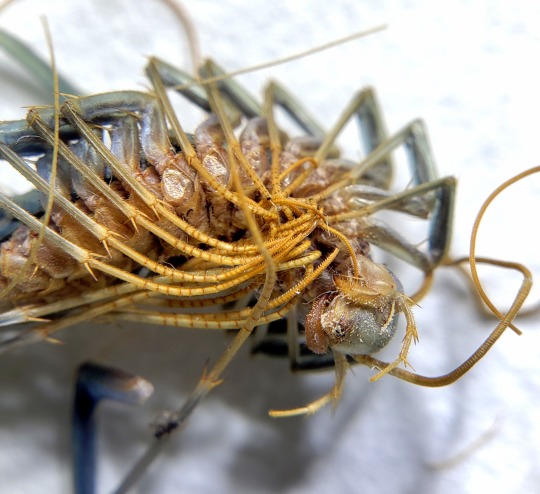



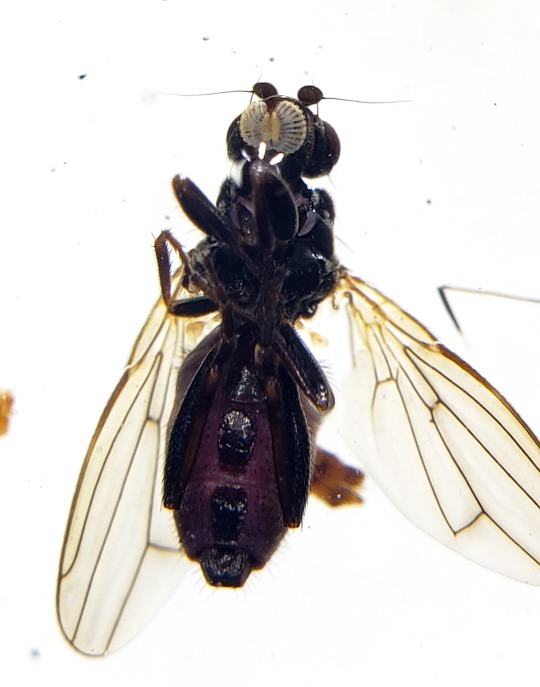
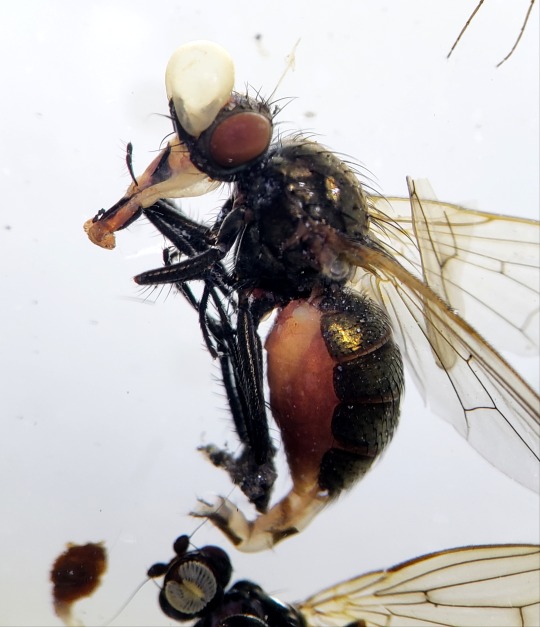
some bugs i saw at work 2.V.2022 - 18.V.2022
#hymenoptera#dryinidae#orthoptera#nematomorpha#coleoptera#histeridae#ditpera#mydidae#curculionidae#cynipidae#acari#orbatidae#diptera#pipunculidae#oestridae#tenebrionidae#chilopoda#Scutigeromorpha#scutigeridae
148 notes
·
View notes
Text

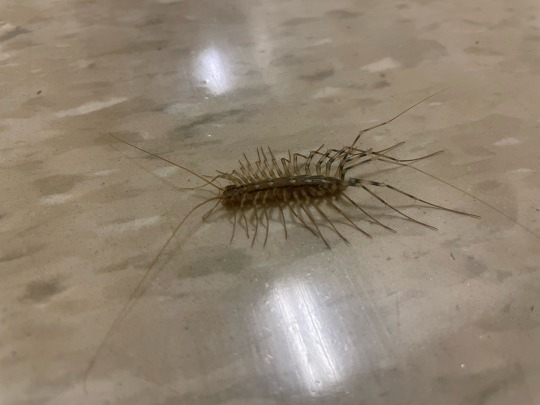
Scutigera coleoptrata
House centipede
Ciempiés doméstico
11 of March 2023 - New York, USA
Young house centipedes are born with four pairs of legs (eight legs total) and with subsequent molts will gain new legs until they eventually reach 15 pairs of legs (thirty legs total). Isn’t that wild? At the time they reach 15 pairs of legs they are considered an adolescent and will go through four more molts before they become an adult. Females can survive for several years. They are nocturnal and feed on a wide variety of insects.
They are originally native to the Mediterranean but were accidentally introduced into the southern United States.
#bugs#bugs i found#house centipede#centipede#centipedes#Chilopoda#Scutigeromorpha#Scutigeridae#Scutigera#Scutigera coleoptrata#original content#a bit late but here we are
106 notes
·
View notes
Text
Centipedes in my dorm room eeueuggggh i know they’re harmless but im just creeped out by themmmm but also i know they eat roaches so i REALLY hope we don’t have roaches too
3 notes
·
View notes
Photo




Thereuonema tuberculata, east asian Scutigeromorph centipede thats (relatively recently) been identified as pretty widely present in the eastern US, with a range stretching from the east coast to as far west as Oklahoma and Nebraska. Most likely they’ve been present for decades and just always misidentified as Scutigera coleoptrata. They generally seem to partition with Scutigera by preferring outdoor habitats, and in the warmer months you can even find them perched up on trees at night, waiting for dinner (delicious moth or hemipteran)
The bottom two are a pair they are Holding Hands
#centipede#centipedes#scutigera#thereuonema#scutigeromorpha#insects#insect photography#wildlife photography#house centipede#bug#bugs
179 notes
·
View notes
Note

I've been waiting to send this to you but have a house centipede eating a German brown cockroach. I don't know why I didn't think they would be carnivorous, but it was a cool find.
yep all centipedes are predators. these funky dudes actually grab their prey by wrapping their legs around it
26 notes
·
View notes
Note
This is kind of random but the first time I saw a house centipede I literally thought it was some sort of alien creature. It had huge greenish legs and was zooming so fast along the floor and I had never seen anything like it before. Most of the pictures I had seen were of like the millipede sort of thing. Unfortunately my Spanish teacher crushed it before I could try and save it :( I literally can't believe I didn't know they existed until I was like 17. Now they are my favorite leggy bois.
They are very strange and unlike other centipedes!
I’m gonna talk about centipedes now and you can’t stop me. Most people in the US are familiar with stone centipedes (order Lithobiomorpha) like the brown centipede - these are the ones you’re likely to find in your garden. They look like this:

Photo by internet_viking
Or tropical centipedes (order Scolopendromorpha) like the common desert centipede, who look like this:

Photo by jnstuart
There are a couple other orders but they’re less familiar to most people. Soil centipedes (order Geophilomorpha) are the very long skinny bois:

Photo by silversea_starsong
Now house centipedes (order Scutigeromorpha) are cool because they don’t look anything like these other dudes. Their body segments are rigid, so it looks like they just have one big body area, and unlike other centipedes, they have compound eyes! Cool. Let’s admire one...


Adorable! Photos by tiwane
Anyhoo RIP to that one your teacher killed. Poor leggy fellow was just trying to live their life...anyway I love centipedes.
#bugs#myriapods#centipede#house centipede#soil centipede#stone centipede#brown centipede#common desert centipede#innocentreticent
119 notes
·
View notes
Text

this old boy molted again! I have had him for 3-4 years (forget when I caught him exactly) but he was adult size then, so my estimate is that he is 6-7 years old and potentially older. he lost a leg in this molt and regrew one he lost last time, but seems hale and hearty and ready to start eating again soon
375 notes
·
View notes
Photo

Baru kali ini menemukan jenis kelabang berkaki panjang 🐛 . #hewan #kelabang #lipan #aneh #unik #fauna #nokturnal #kelabangberkakipanjang #scutigeromorpha
0 notes
Text
Centipedes (from the New Latin prefix centi-, "hundred", and the Latin word pes, pedis, "foot") are predatory arthropods belonging to the class Chilopoda (Ancient Greek χεῖλος, kheilos, lip, and New Latin suffix -poda, "foot", describing the forcipules) of the subphylum Myriapoda, an arthropod group which also includes millipedes and other multi-legged creatures. Centipedes are elongated metameric creatures with one pair of legs per body segment. Most centipedes are generally venomous and can inflict painful bites, injecting their venom through pincer-like appendages known as forcipules. Despite the name, centipedes can have a varying number of legs, ranging from 30 to 354. Centipedes always have an odd number of pairs of legs.[1][2][3] Therefore, no centipede has exactly 100 legs. Similar to spiders and scorpions, centipedes are predominantly carnivorous.[4]:168
Centipede
Temporal range: 418–0 Ma
PreЄЄOSDCPTJKPgN
Late Silurian to present
Lithobius forficatus.jpg
Lithobius forficatus
Scientific classification e
Kingdom:
Animalia
Phylum:
Arthropoda
Subphylum:
Myriapoda
Class:
Chilopoda
Latreille, 1817
Orders and families
Scutigeromorpha
Pselliodidae
Scutigeridae
Scutigerinidae
Lithobiomorpha
Henicopidae
Lithobiidae
Craterostigmomorpha
Craterostigmidae
Scolopendromorpha
Cryptopidae
Scolopendridae
Scolopocryptopidae
Geophilomorpha
Himantariidae
Mecistocephalidae
Neogeophilidae
Geophilidae
Oryidae
Linotaeniidae
Their size can range from a few millimetres in the smaller lithobiomorphs and geophilomorphs to about 30 cm (12 in) in the largest scolopendromorphs. Centipedes can be found in a wide variety of environments. They normally have a drab coloration combining shades of brown and red. Cavernicolous (cave-dwelling) and subterranean species may lack pigmentation, and many tropical scolopendromorphs have bright aposematic colors.
Worldwide, an estimated 8,000 species of centipedes are thought to exist,[5] of which 3,000 have been described. Centipedes have a wide geographical range, even reaching beyond the Arctic Circle.[4] They are found in an array of terrestrial habitats from tropical rainforests to deserts. Within these habitats, centipedes require a moist microhabitat because they lack the waxy cuticle of insects and arachnids, therefore causing them to rapidly lose water.[6] Accordingly, they are found in soil and leaf litter, under stones and dead wood, and inside logs. Centipedes are among the largest terrestrial invertebrate predators, and often contribute significantly to the invertebrate predatory biomass in terrestrial ecosyst










idk i guess im a little “wierd” :P *covered in blood*
33K notes
·
View notes
Photo

Centipedes (from the New Latin prefix centi-, "hundred", and the Latin word pes, pedis, "foot") are predatory arthropods belonging to the class Chilopoda (Ancient Greek χεῖλος, kheilos, lip, and New Latin suffix -poda, "foot", describing the forcipules) of the subphylum Myriapoda, an arthropod group which also includes millipedes and other multi-legged creatures. Centipedes are elongated metameric creatures with one pair of legs per body segment. Most centipedes are generally venomous and can inflict painful bites, injecting their venom through pincer-like appendages known as forcipules. Despite the name, centipedes can have a varying number of legs, ranging from 30 to 354. Centipedes always have an odd number of pairs of legs.[1][2][3] Therefore, no centipede has exactly 100 legs. Similar to spiders and scorpions, centipedes are predominantly carnivorous. Temporal range: 418–0 Ma Scientific classification Kingdom: Animalia Phylum: Arthropoda Subphylum: Myriapoda Class: Chilopoda Latreille, 1817 Orders and families Scutigeromorpha * Pselliodidae * Scutigeridae * Scutigerinidae Lithobiomorpha * Henicopidae * Lithobiidae Craterostigmomorpha * Craterostigmidae Scolopendromorpha * Cryptopidae * Scolopendridae * Scolopocryptopidae Geophilomorpha * Himantariidae * Mecistocephalidae * Neogeophilidae * Geophilidae * Oryidae * Linotaeniidae #macrophotography #macros #macro #ifitfitsyourmacros #macro_captures_ #macroworld_tr #insect #insects #allamphotographer #wildlifephotography #wild #wildlife #wildlifeofinstagram #naturephotography #nature #nikon #nikonphotography @nikonmea @nikonqatarofficial @nikonusa @natgeo @natgeoimagecollection @natgeowild @natgeoabudhabi @natgeoyourshot @naturalmentewild @qatarwildlife @wildlifeplanet #الحريشة https://www.instagram.com/p/CD_2iCQAdHN/?igshid=r4j2759zrblu
#macrophotography#macros#macro#ifitfitsyourmacros#macro_captures_#macroworld_tr#insect#insects#allamphotographer#wildlifephotography#wild#wildlife#wildlifeofinstagram#naturephotography#nature#nikon#nikonphotography#الحريشة
0 notes
Text
Learn about centipedes - Killer thousands of feet on earth
Learn about centipedes - The insect that was dubbed the "thousand foot killer". It is not sour, but this is an arthropod insect. Centipedes are arthropods with each burning is a pair of legs. An adult centipede can be up to 300 feet. Additional characteristics are the pliers in front of their mouth that can secrete venom used for self-defense or hunting. And according to science, most of the world's centipedes are carnivorous.
Learn about centipedes - The master of hunting
In French, centipede also has the name "Bach Tuc" which means thousands of feet. However, this does not mean that centipedes have thousands of feet. Most centipedes have 30-50 feet, but there are also species with numbers up to 350 feet.

The centipedes are usually brown in color, a combination of red and brown colors. Because almost all centipedes live in the ground and narrow, less sun-filled slots. Therefore they are less pigmented and often have a dark color. However, there are species that live in the tropics and lots of sunshine are brighter and more colorful. Centipedes have many different sizes. It may be several millimeters or even up to 30 centimeters. Virtually every centipede earth appears in many different areas and environments. It can be said that their living environment is very diverse. Currently there are 8000 known species of centipedes in the world. However, only 3000 species have been carefully described by science. It is not exaggerated to say that the habitat of the centipede is also exaggerated, as even in the arctic circle, they are walking around. The most humid or habitat environment is underground, vegetation in the tropical rainforest, decaying leaves, ...

It can be said that centipedes are the largest invertebrate predators on land. They also contribute a lot to this earth's biomass.
Learn about centipedes - Life cycle and reproduction
The process of reproduction and fertilization of centipedes does not require mating. The male simply creates a sack and lets the female pick it up. In some centipedes, the semen is placed in a net bag and the male performs a flirtatious dance to persuade his children to receive his pouch. For some other species, the males produce the semen and then leave, letting the females find it for themselves.

In temperate areas, the breeding time of centipedes takes place in spring and summer but in subtropical and temperate areas it seems that centipedes do not have a seasonal breeding cycle. At the same time, some centipedes are monogamous. For Lithobiomorpha and Scutigeromorpha sets, scrape the dug into a small hole, lay eggs in it and then fill it up and leave. Number of eggs ranges from 10-50 fruits. The time of "hatching" eggs lasts depending on the species, maybe from 1 month to several months. Sexual maturity is not the same, such as S. coleoptera which takes up to 3 years to mature sex, while Lithiobiomorpha in suitable conditions takes only 1 year. Compared to insects, fairly long-lived centipedes, such as Lithobius forficatus can live up to 5 or 6 years. Due to the low number of eggs produced, the time of hatching and the maturity of sexual maturity, many opinions suggest that centipedes are animals belonging to the selected group. more children. Each litter lays 15-60 eggs in a nest in a tree trunk or humus. After laying, remove the remaining side of the nest, keep an eye on the eggs, lick off the eggs to protect them from fungal infections; After the eggs hatch they continue to watch the children until the centipedes can establish themselves - the time with their children can last up to 1 year.

However, in some cases, maternal centipedes can eat eggs or leave eggs infected and die. Some centipedes of Scolopendromorpha have a real sample behavior, ie a voluntary mother centipede to give birth to their newborn babies. Craterostigmomorpha's reproductive life cycle and behavior have not been revealed until now. Through the above article, we can know that centipedes are animals that are dangerous to human health if they encounter them. Therefore, we need to prevent them in particular and other harmful insects in general.
Viewmore: Learn about ants three species (name in Vietnam)
Viet Thong mesh door is one of the most simple and economical products to protect you and your family. With a wide variety of models and designs for customers to choose from. Viet Thong is committed to quality on each product. If the customer needs it, contact the information below.
Viet Thong mesh gate company
Address: 130C To Ngoc Van, Thanh Xuan Ward, District 12, Ho Chi Minh City
Hotline: 0355 468 468
Email: [email protected]
0 notes
Text
Centopeia: descubra tudo sobre esse animal
A centopeia pertence ao grupo de animais invertebrados do filo dos artrópodes e da classe Chilopoda (quilópodes). Quilópodes é uma palavra grega que significa “quilo”= “mil” e “podos”= “patas”. Ou seja, é um grupo de animais que possui como característica principal, a grande quantidade de pernas articuladas.
Os quilópodes são pequenos, em geral medem de 2 a 7 cm de comprimento, e possuem o corpo composto por vários “anéis” interligados, apresentando um par de pernas por segmento. Os grupos de animais que representam os quilópodes são as centopeias e lacraias. Atualmente, existem quase 3 mil espécies de quilópodes.
A aparência repulsiva culturalmente percebida pela maioria dos seres humanos provavelmente é a razão pela qual as centopeias sejam consideradas como perigosas e quase sempre exterminadas.
Centopeias são quilópodes, que significa “mil patas” (Foto: depositphotos)
Características da centopeia
São animais que apresentam corpo delgado, comprido, segmentado e achatado dorsoventralmente ou redondo, lembrando piolhos de cobra, de modo geral. Possuem uma cabeça bem diferenciada com um par de antenas articuladas e com mandíbulas, mas não existe uma diferenciação entre tórax e abdômen.
As centopeias geralmente têm coloração marrom, mas podem apresentar uma ampla variedade de cores, incluindo tonalidades claras de vermelho, preto, amarelo e verde ou até mesmo faixas azuis transversais em seu dorso.
No primeiro segmento do corpo da centopeia estão as glândulas de peçonha – o aguilhão (Foto: depositphotos)
As centopeias possuem um par de pernas por segmento, cujo número varia de 15 a mais de 180. O último par de pernas é sensorial e defensivo e não locomotor, e os dois últimos segmentos do tronco não têm pernas. A maior centopeia, Scolopendra gigantea, chega a atingir quase 30 cm de comprimento.
A Scolopendra gigantea pode atingir quase 30 cm de comprimento (Foto: depositphotos)
Alimentação
Os animais quilópodes são predadores ativos, carnívoros e se alimentam de pequenos artrópodes, vermes, insetos, como: besouros, larvas, minhocas, e até alguns pequenos vertebrados, como: aves, rãs e cobras. Todos esses animais são capturados vivos, imobilizados e inoculados por peçonha.
A presa é detectada e localizada por contato através das antenas, ou com as pernas e, então, é capturada e morta, ou atordoada com as garras de veneno. Certas espécies não se alimentam quando desprovidas de suas antenas.
A digestão acontece por um tubo que tem início na boca e termina no ânus. Os detritos passam do sangue, através das finas paredes dos túbulos de Malpighi para o lúmen, e depois para o intestino.
Trocas gasosas e excreção
As trocas gasosas são efetuadas através de um sistema traqueal. Há um par de espiráculos por segmento. O espiráculo, que não pode ser fechado, abre-se em um átrio revestido de pelos cuticulares (tricomas) que podem reduzir a dessecação ou impedir a entrada de partículas de pó.
Os tubos traqueais se abrem na base do átrio e terminam em pequenos tubos cheios de líquido que fornecem oxigênio diretamente para vários tecidos.
O sistema excretor dos quilópodes possui duas estruturas que filtram os líquidos corporais. Elas recebem o nome de Malpighi e apresenta uma ou duas aberturas para realizar a excreção.
Grande parte dos detritos nitrogenados é excretada como amônia e não como ácido úrico. As centopeias requerem ambiente úmido para manter um balanço hídrico apropriado, pois o tegumento não possui a cutícula cerosa dos insetos e aracnídeos.
Reprodução
Nos machos há de 1 a 24 testículos, localizados acima do intestino médio. Os testículos estão ligados a um único par de ductos espermáticos que se abrem através de um gonóporo mediano no lado ventral do segmento genital.
A transmissão de espermatozoides é indireta nos quilópodes. Em geral, o macho constrói uma pequena teia de fios de seda secretada por uma fiandeira localizada no átrio genital. Um espermatóforo é colocado na teia. A fêmea apanha o espermatóforo e o coloca na sua abertura genital. Os gonópodos de cada sexo auxiliam na manipulação do espermatóforo.
O macho geralmente só produz um espermatóforo ao encontrar a fêmea, e frequentemente há um comportamento inicial de corte. Este comportamento pode durar até uma hora antes do macho depositar o espermatóforo.
O macho então “sinaliza” para a fêmea ao tocar nas antenas dela e ela responde rastejando-se em direção ao macho e apanha o espermatóforo.
Após a corte, a fêmea rasteja em direção ao macho para realizar o acasalamento (Foto: depositphotos)
A peçonha da centopeia
No primeiro segmento do corpo da centopeia há uma estrutura chamada forcípula, onde estão as glândulas de peçonha – o aguilhão – aparelho inoculador de veneno. No Brasil, existem cerca de dez espécies cuja picada é temida, sendo as principais a Scolopendra viridicornis, S. subspinipes, Otostigmus scabricauda, Cryptops iheringi e Octocryptops ferrugineus. A S. viridicornis é a mais comum no nosso país.
O veneno das centopeias foi pouco estudado, mas sabe-se que, pelo menos em algumas espécies, contém proteínas, lipídios, lipoproteínas, histamina, hialuronidase, polipeptídeos e proteinases.
Geralmente a sintomatologia decorrente da picada de uma centopeia é apenas local, com dor instantânea, intensa, como se fosse uma queimação, que cessa em aproximadamente 24 horas, acompanhada de hiperemia e edema local.
Em casos mais raros pode ocorrer dor irradiada, necrose local, taquicardia, linfadenite e sintomas sistêmicos como febre, tremores, calafrios, sudorese, dispneia, cefaleia, vômito e ansiedade.
Grandes centopeias são geralmente temidas, mas o veneno da maioria delas, embora doloroso, não é suficientemente tóxico para ser letal ao ser humano.
Defesa
As centopeias também utilizam o veneno como mecanismo de defesa, podendo ser mortal para algumas espécies de animais e causando fortes dores e alergias para os seres humanos.
Órgãos sensoriais
Alguns habitantes das cavernas não possuem olhos e outros quilópodes possuem de poucos a muitos ocelos. Em algumas espécies, os ocelos estão agrupados e organizados de modo que formam olhos compostos. Entretanto, não há evidência de que esses olhos compostos funcionem mais do que na simples detecção do claro e escuro.
Um par de órgãos de Tomosvary está presente na base das antenas. Os poucos estudos sobre esses órgãos sugerem que eles detectam vibrações, talvez auditivas. O último par de pernas das centopeias tem uma função sensorial, elas estão modificadas para formar um par de apêndices anteniformes, dirigidos para trás.
Qual o habitat das centopeias?
O habitat dos quilópodes é principalmente em locais escuros e úmidos. Normalmente eles são encontrados embaixo de pedras, troncos, cascas de árvores, geralmente aquelas que estão em processo de apodrecimento, entulho de lixo e nas redes de esgoto. A maioria possui hábitos noturnos e vive na zona entremarés.
São animais solitários, representados por espécies que vivem em climas quentes. Em todo mundo, são conhecidas cerca de 1.100 espécies, mas as estimativas são de que existem aproximadamente 2.500. Para a região Neotropical há cerca de 200 espécies descritas, das quais 150 vivem no Brasil.
Os quilópodes se distribuem em cinco ordens: Geophilomorpha, Scolopendromorpha, Lithobiomorpha, Scutigeromorpha e Craterostigmomorpha (esta presente apenas na Tasmânia e Nova Zelândia).
Importância
As centopeias cumprem um papel decisivo na natureza ao controlar espécies de insetos das quais se alimentam. Apesar da visão negativa prevalecer na relação cultural ser humano/quilópodes, observa-se que as centopeias vêm desempenhando papéis significativos na medicina, religião, literatura, mitologia, artes gráficas e plásticas, recreação e alimentação de quase todas as sociedades humanas.
Nas práticas médicas tradicionais, a centopeia é um recurso zooterápico recomendado para o tratamento de diferentes enfermidades. Na antiguidade, o linimento de centopeia era um dos remédios comuns para tratar problemas de garganta.
Na Europa, a infusão de pequenas centopeias em vinho era um bom remédio contra a icterícia e a retenção de urina. O medicamento homeopático Scolopendra obtido da centopeia asiática é recomendado para o tratamento de dor ciática.
Na Coreia do Sul, a Scolopendra é utilizada para curar problemas nas articulações, pernas e pés. Também são recomendadas para o tratamento de derrame, convulsões, tétano, laringite, carbúnculo, mordida de cobra e inchaços.
Pesquisas medicinais
Algumas pesquisas apontam a importância desses animais para o tratamento de algumas doenças. Pesquisas clínicas e farmacológicas registraram efeitos anticonvulsivante e antineoplásico, uma vez que as preparações de Scolopendra inibiram convulsões geradas por estricnina e pentilenetetrazol em animais de laboratório, assim como inibiram o crescimento de diversas células neoplásicas in vitro.
Também foram obtidos efeito antifúngico e bons resultados contra a difteria. Deve-se esperar a descoberta de algum novo antibiótico, uma vez que as fêmeas de algumas espécies cobrem a massa de ovos com uma secreção fungicida.
As centopeias e a cultura
No Egito Antigo, a centopeia era símbolo do deus Sepa, um deus funerário venerado em Heliópolis e invocado contra os animais malignos e os inimigos dos deuses. A centopeia era considerada um animal da terra, enquanto a serpente pertencia ao céu. Era também um hieróglifo nos textos das pirâmides.
A cultura maia também venerava esse animal. No Japão, a centopeia gigante forma parte de algumas lendas samurais. Em Barbados, acredita-se que, quando uma centopeia cruza o caminho de alguém, significa que o indivíduo tem um inimigo e, portanto, o animal deve ser morto.
Também é costume crer que conversas sobre centopeias podem encorajá-las a invadir residências.
Referências
» BARROSO, Eduardo et al. Centipede accidents notified, Revista da Sociedade Brasileira de Medicina Tropical, v. 34, n. 6, p. 527-530, 2001.
» AGUIRRE, Elisa Chaparro. Estudo da resposta imune inata em quilópodes (Scolopendromorpha Myriapoda). 2017. Tese de Doutorado. Universidade de São Paulo.
» CHAGAS JÚNIOR, Amazonas. Revisão das espécies neotropicais de Scolopocryptopinae (Chilopoda: Scolopendromorpha: Scolopocryptopidae). 2003.
O post Centopeia: descubra tudo sobre esse animal apareceu primeiro em Estudo Prático.
Centopeia: descubra tudo sobre esse animal publicado primeiro em https://www.estudopratico.com.br
1 note
·
View note
Note
will you please tag house centipedes? 😰 I'm sorry but they are the one bug I am horribly afraid of, even in cute little mittens.
I’ll tag them #scutigeromorpha
2 notes
·
View notes